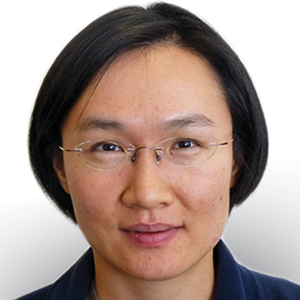Meet the Newest MSE Career Award Winners
Wanzheng Hu

In September 2017, physicist Wanzheng Hu moved from Germany to the United States to begin teaching at BU, despite having never stepped foot in the US before. She has since established the Hu lab, which focuses on the interaction between light and quantum materials. With her NSF CAREER award funding, Hu, a BU College of Arts & Sciences assistant professor of physics, materials science and engineering, is experimenting with high-temperature superconductors, using ultrashort laser pulses to control the arrangement of atoms in iron-based materials. Superconductors can power high-field magnets, generating high magnetic fields for magnetic resonance imaging (MRI) and other technologies.
“We hope to have a better understanding of high-temperature superconductivity in iron-based superconductors, and hopefully better understand high-temperature superconductivity in general,” says Hu.
While working from home, she has been practicing the flute, but Hu says she is eager to return to her lab space at BU, where her team has an array of high-intensity lasers—many of which Hu custom-built herself—and various pieces of optical machinery, technology she is looking forward to sharing with K-12 students through a program she is launching with the NSF CAREER funding.
Hu also recently received a Department of Energy Office of Science Early Career Award to research different materials with a range of applications, including high-temperature superconductivity and ultrafast information processing.
“Oftentimes physicists start from a proposed experiment, but end up at a different result. That is very exciting because we always learn something new,” says Hu. “That is why I love to be an experimentalist.”
Xi Ling

Xi Ling, a BU College of Arts & Sciences assistant professor of chemistry and materials science and engineering, is determined to shed new light on a well-established technique in chemistry known as surface-enhanced Raman scattering (SERS), a method used to enhance Raman spectroscopy—which can detect the composition of a substance by analyzing how light scatters on the surface of its molecules as they vibrate. With support from the NSF CAREER award, Ling is hoping to pave the way for even better chemical sensing techniques using interactions between light and matter.
“Building on the fundamental understanding of the Raman-enhancement effect, we will explore the role of 2D crystals in overcoming the key problem of reproducibility of SERS,” says Ling. SERS is usually done using metal nanoparticles of gold or silver to enhance light scattering, but since the surfaces of these 3D nanoparticles are often not perfectly uniform, the same results are not always reproducible between analyses. But 2D crystals, Ling explains, have atomically flat surfaces, which avoids issues posed by 3D metal nanoparticles and allows for more precise analysis of how light interacts with materials.
“We hope to gain a better understanding of how molecules interact with material surfaces,” says Ling. “We would also like to demonstrate a highly sensitive and selective platform for molecule sensing using this technique.”
Ling has found in her previous work that interaction between light molecules and 2D materials can reveal the Raman-enhancing mechanisms at play, which could lead to new and highly sensitive methods of chemical sensing for food safety, disease diagnosis, and environmental monitoring. Students involved in the project will also acquire advanced understanding of light-matter interactions, says Ling, which is the basis of many common applications, like solar cells that convert light energy into electricity.
“I hope our contribution will eventually lead to the development of a microsensing technology with high sensitivity, selectivity, and reproducibility,” says Ling.